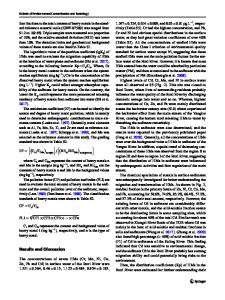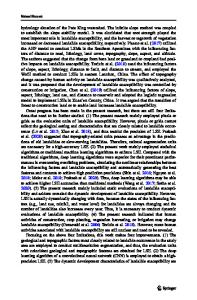Disintegration characteristics of moderately weathered mudstone in drawdown area of Three Gorges Reservoir, China
- PDF / 3,739,898 Bytes
- 10 Pages / 595.276 x 790.866 pts Page_size
- 6 Downloads / 393 Views
ORIGINAL PAPER
Disintegration characteristics of moderately weathered mudstone in drawdown area of Three Gorges Reservoir, China Zhenhua Zhang 1,2 & Wu Liu 1,3 & Qiang Cui 4 & Lei Han 1 & Huayan Yao 1 Received: 4 November 2017 / Accepted: 19 July 2018 # Saudi Society for Geosciences 2018
Abstract Mudstones in the drawdown area are prone to disintegration under cyclic wetting-drying conditions during reservoir operation, which is unfavorable for bank slope stability. To study the influence of cyclic wetting-drying conditions on disintegration characteristics, disintegration tests with 11 wetting-drying cycles are conducted on mudstones from the Three Gorges Reservoir area. Experimental results show that in the first five wetting-drying cycles the disintegrated mass increases rapidly, while micropores, fractures, and flaky aggregates distributed on the surface generally develop, but afterwards the disintegrated mass changes slightly and the surface tends to be smooth. Then, a mathematical model based on the proposed disintegration index is established to quantitatively evaluate mudstone’s disintegration characteristic. The disintegration index generally decreases obviously in the first five wetting-drying cycles and approaches to 0 with little fluctuation after then. After 11 wettingdrying cycles, disintegration of the tested mudstone nearly tends to stop and does few adverse effects on bank slope stability. Keywords Mudstone . Disintegration characteristic . Cyclic wetting-drying . Disintegration index
Introduction Being the largest reservoir in China, the Three Gorges Reservoir (TGR) is stretched from Yichang city to Chongqing city with a total area of 1084 km2 (Fig. 1). After the impoundment of the reservoir, the drawdown area with average vertical height of 30 m has been formed due to yearly fluctuations of reservoir water level between 145 and 175 m (Zhang et al. 2014). Due to intense water-rock interaction between soft rocks and water (Liu et al. 2009; Shen and Xu 2011; Shen et al. 2014; Deng et al. 2016), mudstones in the
* Wu Liu [email protected] 1
School of Civil Engineering, Hefei University of Technology, Hefei 230009, Anhui Province, China
2
Collaborative Innovation Center for Geo-Hazards and Eco-Environment in Three Gorges Area, Yichang 443002, Hubei Province, China
3
Rock Mechanics in Hydraulic Structural Engineering, Ministry of Education, Wuhan University, Wuhan 430072, China
4
Transmission and Transformation Engineering Department, China Electric Power Research Institute, Beijing 102401, China
drawdown area on bank slopes of the TGR, mainly composed of smectite, illite, kaolinite, feldspar, and quartz, may disintegrate as a result of undergoing wetting-drying cycles during the periodic fluctuations of reservoir water level, which is unfavorable for bank slope stability and may even cause slope instability (Yu et al. 2002; Yin and Hu 2004; Ghobadi and Mousavi 2014; Liu et al. 2014; Hua et al. 2015; Deng et al. 2016). In order to study the disintegration behavior of mudstones under cycl
Data Loading...











